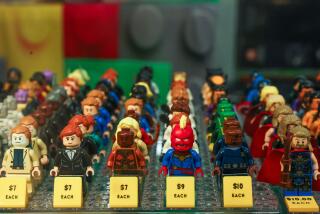Price-Less Items Make Shopping More of a Task
“No price on it, as usual,” grumbled a shopper as she plucked a Baby Doll Magic Milk Bottle from a shelf at Target in Duarte. No price for the toy was posted on the shelf, either.
In the days before Christmas, quite a number of toys sold at Target--from stocking stuffers to the popular Little Pet Shop--lacked prices. Signs posted throughout stores chainwide alerted shoppers: “Price tickets are not on selected items. The price will be scanned at checkout.”
A company spokeswoman said that Target isn’t doing anything new. The company has selectively omitted prices on toys and other items since 1987. “We were among the first to introduce scanner pricing,” the spokeswoman said.
Target isn’t the only retailer to inject mystery into pricing. At Affordable Portables, a small Lake Forest-based electronics chain, no prices are posted anywhere in the store. (We called to ask why, but the company’s general manager didn’t return our call.) The practice is legal. California law requires only grocery stores, or grocery departments in general merchandise stores, to post prices.
But the failure to post prices isn’t consumer-friendly. It stymies comparison shopping--consumers have to collar a clerk or haul merchandise to the checkout to get a price. How many shoppers, pressed for time during the holidays, will walk away from a purchase after putting in all that effort?
*
Santa was good: Continuing a decade-long pattern of indulgence, Americans are expected to spend up to $18.36 billion on toys this year, up 8% from 1992.
The projected total climbs to $24.4 billion if estimates for video games are included.
According to figures supplied by the industry group Toy Manufacturers of America, toy spending has galloped well ahead of inflation over the last 10 years. Americans spent an average of $136.03 on toys for each child under age 18 in 1982. By 1992, that figure had climbed 87% to $254.63 per child.
The U.S. Bureau of Labor Statistics reports that the cumulative inflation rate for those years was 51%.
*
Are these kids getting enough homework? Possibly the most sought-after toy this Christmas season is Mighty Morphin Power Rangers, a new action figure toy based on a TV show of the same name. Neither Toys R Us nor Target can keep the toys in stock.
What’s behind the unexpected demand? Saban Entertainment of Burbank announced last week that the Power Rangers after-school program has been the No. 1 show among children ages 2 to 11 for eight weeks running. The Saturday morning version is pulling high ratings, too.
*
Video junk food: Arriving this Christmas is a new video game for the Sega Genesis system called “McDonald’s Treasure Island Adventure.” What makes this game different from most is that it is built around a consumer product: McDonald’s fast-food restaurants.
Featuring Ronald McDonald, the game doubles as a not-too-subtle pitch for the company’s restaurants, and there’s more of its ilk on the way.
Coming soon for both Sega and Nintendo systems is “Chester Looks for Hip City USA,” starring Chester Cheetah, the cartoon spokescat for Frito-Lay’s Cheetos snacks. The Sega version features tiny bags of Cheetos.
Cross-promotion isn’t new to video games. Plenty of games are based on cartoon characters and movies (many of them R-rated). There’s a Nintendo game that is little more than a tour of Disneyland. But the recent move by video game companies to place consumer product images in games brings the promotional frenzy to a new level.
A representative of Sega wasn’t available to comment. George Harrison, Nintendo director of marketing, acknowledges that the games are a form of advertising. “We couldn’t say yes to characters based on toys and movies but tell the food companies no,” he said.
Harrison said that while the company permits characters representing consumer products, it does not permit the product itself to appear in a game. He said: “We fundamentally have a problem with asking people to pay for a game whose main reason for being is to hawk a product.”
Top 10 Toys of 1993
1. Barney the Dinosaur
2. Hollywood Hair Barbie
3. Batman action figures
4. Jurassic Park action figures
5. Sega Genesis
6. Super Nintendo Entertainment System
7. Littlest Pet Shop
8. Magic Tea Party
9. G.I. Joe action figures
10. Teenage Mutant Ninja Turtles action figures
Source: Playthings magazine
More to Read
Inside the business of entertainment
The Wide Shot brings you news, analysis and insights on everything from streaming wars to production — and what it all means for the future.
You may occasionally receive promotional content from the Los Angeles Times.










